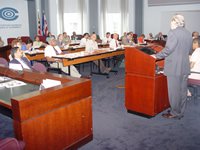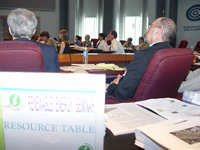 Up-and-coming technologies, cleaner air, and more affordable sources of electricity were all part of discussions at a Renewable Energy Seminar.
Up-and-coming technologies, cleaner air, and more affordable sources of electricity were all part of discussions at a Renewable Energy Seminar.
Sources of renewable energy – energy that’s obtained from resources that are non-depleting and naturally replenishing -- are generally non-fossil fuel based and include wind, solar, photovoltaic, biomass, geothermal, and hydropower. During the six-hour event on June 22, panelists discussed how its use can improve air quality, lower energy costs and reduce dependence on imported oil and keep the public safe.
Noting a felled tree that left 50 million customers in Ohio and part of the Northeast corridor, without power for a week, Jim Woosley, vice president of Booz Allen Hamilton and former director of the Central Intelligence Agency, expressed concern that over-reliance on electricity grids makes cities and regions vulnerable to potential terrorist attacks.
“Security is very close to the top of concerns we have, but thankfully it dovetails with many other important concerns such as the environment,” Woosley said. 
As local businesses and agencies seek new ways to make buildings more energy efficient, the COG-sponsored seminar brought together industry experts and local policy makers to discuss new markets for cleaner fuels and environmentally-friendly power sources. Panelists discussed the various ways that companies and agencies can use sources of renewable energy, as well as government incentives for applying new technologies. Montgomery County, for instance, will be implementing a new program later this year that will allow rebates to residential and business owners who purchase renewable power.
Several COG member jurisdictions are exploring options for more energy-efficient communities. The District of Columbia and Montgomery County have begun purchasing wind power, and other jurisdictions are considering sources of solar energy. Additionally, Takoma Park and the counties of Arlington and Fairfax have made commitments to use a wind power.
Great strides have been made, panelists say, in spreading the use of renewable energy. Worldwide, wind power generation has more than tripled in the last five years and now generates enough electricity to serve more than 9 million American homes. Just two percent of electricity comes from oil now, compared with 20 percent in the 1970s.
“You really have the power to make policies that can have a remarkable change in energy in your states, and to begin to bring the U.S. closer to where it needs to be,” Colin Murchie, director of legislative affairs Solar Energy Industries Association, told local elected officials attending the seminar. See the agenda and presentation from this session listed below for more information.